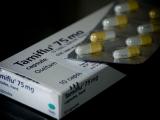May 14, 2013
Harris Poll: 2012-13 flu season fairly typical
The 2012-13 influenza season was fairly typical in terms of those who reported having the flu and those who said they got vaccinated, according to a Harris Poll of 2,345 US adults released today. The poll found that 14% of respondents believe they had the flu last winter, compared with 18%, 12%, 11%, and 11% in the previous four seasons. And 44% said they received flu shots, compared with 40%, 39%, 44%, and 40% in the previous seasons, Harris Poll said in a news release. The findings don't fit very well with reports of flu activity issued during the season, which suggested the epidemic was worse than average. The percentage of poll respondents who said they thought they had the flu differed little between those who received the vaccine and those who didn't, the release said, which has been the case for most Harris Polls over the last 9 years. "However, it would be a mistake to conclude from this that the vaccine was ineffective," the
release said. "There is clear evidence in this poll that people who were more vulnerable were also more likely to have received shots." Harris Poll Chairman Humphrey Taylor added, "The diagnosis, and particularly self-diagnosis, of the flu is not very reliable," among other shortcomings of the poll. Because respondents are drawn from a pool of people who have agreed to participate in Harris Interactive polls, "no estimates of theoretical sampling error can be calculated," the news release said.
May 14 Harris news release
Jan 18 CIDRAP News story on midseason assessment of flu
WHO reports low flu levels worldwide
The Northern Hemisphere flu season is coming to an end, with inter-seasonal levels seen in much of North America, Europe, and northern Asia and with only low transmission levels persisting in a few countries, the World Health Organization (WHO) said in updates yesterday and on May 10. The low-level persistence is associated with lingering influenza B activity in some areas in North America and Europe, the agency said. Low flu activity has also been reported in the tropics and Southern Hemisphere, the WHO said. Pandemic 2009 H1N1 viruses were predominant globally in the past 2 weeks, followed by H3N2 and influenza B, the agency said. All strains match well with those in the vaccine.
May 13 WHO virus-activity update
May 10 WHO surveillance update
FDA releases food defense planning software tool
The US Food and Drug Administration (FDA) yesterday released a computer software program to help food companies and retailers with risk assessment and planning for protecting their products from intentional contamination. Called the Food Defense Plan Builder, the program walks owners and operators through crafting a customized plan that reflects the FDA's guidance documents and incorporates the agency's other related planning resources. Food defense plans are voluntary, and the FDA recommends them as a way to help protect the nation's food supply against biological, chemical, and radiological attacks. The software is available as a free download on the FDA's food defense Web site. The agency is hosting a series of 1-day workshops to help food industry members use the tool to develop food defense plans. The first one is May 28 in Pleasanton, Calif.
May 13 FDA press
release
FDA food defense home page
New rotavirus vaccine developed in India billed as effective, cheap
A new rotavirus vaccine that was developed in India with US support has been proved safe and effective in clinical trials and promises to offer a cheaper option for developing countries trying to protect children from the virus, according to press reports and US officials. The Indian government announced today that in a phase 3 trial, the vaccine, called Rotavac, reduced severe cases of diarrhea by 56% in the first year of life, the Associated Press (AP) reported. Anthony Fauci, MD, head of the US National Institute of Allergy and Infectious Diseases (NIAID), which supported development of the vaccine, said the trial results represent "a significant victory for India's scientific community." The Indian maker of the vaccine, Bharat Biotech, has pledged to sell it for $1 a dose, well below the $2.50 a dose that developing countries pay for two existing rotavirus vaccines, the AP reported. The vaccine was developed
through a broad public-private partnership that included the NIAID, the Indian government, the US Centers for Disease Control and Prevention, private foundations, and others, according to the AP and NIAID. Seth Berkley, CEO of the GAVI Alliance, which works to provide vaccines to the world's poor, called the vaccine "a big deal," because it will improve access to and the supply of rotavirus vaccines. The AP said Rotavac needs to be licensed in India before it can be used there and will need WHO approval before it can be distributed globally.
May 14 Fauci statement



















